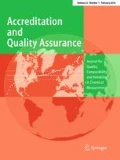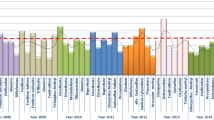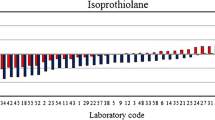Abstract
The Italian National Reference Laboratory (NRL) for pesticide residues yearly organizes proficiency tests (PTs) on olive oil in cooperation with the International Olive Council, addressed to European laboratories (NRLs, official control laboratories, and private laboratories), involved in the National and European monitoring programs. The main aim of these PTs is to compare the performances of the laboratories in Mediterranean and European countries and to promote mutual acceptance of pesticide residue data regarding the analytical controls of olive oil. In this paper, a description of the last PT named COIPT-16 is presented. The test material consisted of a commercial olive oil spiked with six different pesticides. The assigned value of each analyte was determined as a consensus value based on the results of the participants calculated using Algorithm A of the ISO 13528:2015. As relative target standard deviation in the z score formula, the 25 % of the robust mean value was considered. The global performance of each participating laboratory was assessed by calculating the average of the squared z scores only for laboratories that have detected at least 80 % of the analytes present in sample achieving the sufficient scope as indicated in the initial protocol. Two compounds, alpha-endosulfan and beta-endosulfan have been analyzed again in this PTas in the previous PT to compare the performances of the laboratories whose supplied results both PTs. The quick, easy, cheap, effective, rugged, and safe methodology was used by the majority of laboratories corresponding to 64 % of participants.



Similar content being viewed by others
References
European Parliament and Council. Regulation (EC) n. 882/2004 of the European Parliament and of the Council of 29 April 2004 on official controls performed to ensure the verification of compliance with feed and food law animal health and animal welfare rules. In: Official Journal of the European Union L165/1
European Commission. Commission implementing Regulation (EU) n 1274/2011 of 7 December 2011 concerning a coordinated multiannual control program of the Union for 2012, 2013 and 2014 to ensure compliance with maximum residue levels of pesticides and to assess the consumer exposure to pesticide residues in and on food of plant and animal origin. In: Official Journal of the European Union L325/24
European Council Regulation (EC) No 396/2005 of the European Parliament and of the Council of 23 February 2005 on maximum residue levels of pesticides in or on food and feed of plant and animal origin and amending Council Directive 91/414/EEC. Official Journal of the European Union L70/1
European Council. Commission Regulation (EC) n. 149/2008 of 29 January 2008 amending regulation (EC) n. 396/2005 of the European Parliament and of the Council by establishing Annexes II, III and IV setting maximum residue levels for products covered by Annex I thereto. In: Official Journal of the European Union L58/1
Italian Ministerial Decree of 23 December 1992 transposing the Community Directive 90/642/EEC on the fixing of maximum levels for pesticide residues in and on certain products of plant origin including fruit and vegetables. Official Journal of the European Communities no. L350/71
ISO/IEC 17025:2005 General requirements for the competence of testing and calibration laboratories. ISO, Geneva
Directorate General for Health and Food Safety (2015) Guidance document on analytical quality control and method validation procedures for pesticide residues analysis in food and feed. SANTE/11945/2015 Brussels, Belgium
ISO 13528:2015 Statistical methods for use in proficiency testing by interlaboratory comparisons, 2nd edn. International Organization for Standardization, Geneva
European Commission (2016) EU Reference Laboratories for residues of pesticides. General protocol for EU proficiency tests on pesticide residues in food and feed, 6th edn. http://www.eurl-pesticides.eu
Medina-Pastor P, Rodriguez-Torreblanca C, Andersson A, Fernandez-Alba AR (2010) European Commission proficiency tests for pesticides residues in fruits and vegetables. Trends Anal Chem 29(1):70–83
IBM SPSS Statistics 24
Thompson M (2007) Proficiency testing: assessing z-scores in the longer term. Analytical Methods Committee. AMCTB 16
UNI EN 15662 (2009) Determination of pesticide residues using GC-MS and/or LC-MS/MS following acetonitrile extraction (partitioning and clean-up by dispersive SPE—QuEchERS—method. UNI, Milano
Author information
Authors and Affiliations
Corresponding author
Electronic supplementary material
Below is the link to the electronic supplementary material.
Rights and permissions
About this article
Cite this article
Generali, T., Stefanelli, P., Girolimetti, S. et al. Results of the 16th proficiency test on the determination of pesticide residues in olive oil. Accred Qual Assur 24, 13–18 (2019). https://doi.org/10.1007/s00769-018-1329-5
Received:
Accepted:
Published:
Issue Date:
DOI: https://doi.org/10.1007/s00769-018-1329-5




